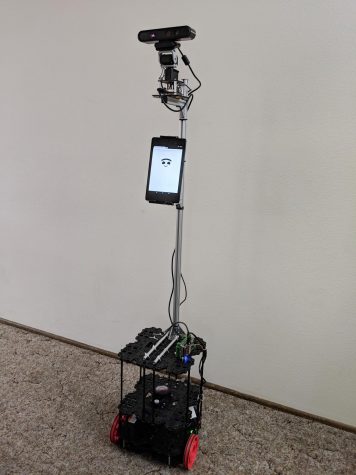Robot helps those with memory impairment
Mechanism can help adults take medication, do day to day activities
EUGENE LEE | THE DAILY EVERGREEN
Nisha Raghunath, graduate student in WSU’s experimental psychology program, talks about her contributions to the creation of the RAS on Friday in Johnson Tower.
January 23, 2019
WSU’s engineering, psychology and computer science departments worked together to develop a robot to help older adults with memory impairment.
The robot, also called Robot Activity Support (RAS), is meant to help older adults do daily activities like taking medication, said Bryan Minor, associate in research with the school of electrical engineering and computer science.
“The baby boomers — that generation — they’re all aging into the older adult age [65 years and older] right now,” said Nisha Raghunath, graduate student in WSU’s experimental psychology program and RAS’s co-creator. “By the year 2030, one in five people is going to be an older adult.”
She said as people age, cognitive impairment is more likely, and many older adults want to age in their own homes.
“This robot is not meant to take the place of a caregiver, but ease the burden of caregiving,” Minor said.
Raghunath said the robot is tested in a “smart” apartment located at Chinook Village. The robot uses data from the apartment’s sensors and video footage as well as the robot’s own sensors and video footage to do its tasks, hence the smart label.
She said the robot is still in its early stages, but the team is testing it with young and older adults.

Bryan Minor, associate in research at WSU’s school of electrical engineering and computer science, said the Robot Activity Support is meant to ease the burden of caregiving.
To test the robot’s abilities, people needed to do tasks that require the use of the robot. One task they tested was preparing to walk a dog, she said.
The task required the person to pick up an umbrella, dog leash, keys and the dog, each of which had a sensor. The last step was to open and shut the front door, Raghunath said.
If any of the steps were missed, the robot would come to the person and ask if they wanted help on a tablet interface, she said. If they pressed yes, the robot would prompt them to watch a video that goes through all the steps or just the step they forgot. The robot could also bring them to the item they forgot.
Raghunath said once the person accomplished the step they forgot, they could tell the robot they did the step and the robot will return to its home position.
“It continuously monitors the person’s activity, waiting for a misstep or a break from the usual pattern it has established,” she said.
Minor said the next step in the project is to test the robot in an actual home for a week to see how well the robot will work in a real-world environment.
Raghunath said the home would be outfitted with sensors, and the robot would learn activity sequences a person does on a daily basis.
Minor said they also plan to refine the tablet interface with a computer science team to make the interface compatible with voice control.
Raghunath said some of the feedback they received after testing the robot with younger adults is it does not move fast enough. Older adults, on the other hand, said they appreciate the robot’s current speed.
“You can argue that it doesn’t matter what younger adults think of this robot because we have different expectations and needs from technology,” she said.
The 50 people who have tested this robot responded well to it, she said.
“The real question is, do you want a robot helping you when you’re in that stage of your life or do you want a human helping you?” Raghunath said. “The reviews are kind of mixed.”
She said some people favor the robot because they think it preserves a person’s sense of dignity. When someone knows they have memory impairment, they do not necessarily want to ask someone else for help. With a robot, they might not have the same reluctance.
Minor said they want to make care-giving easier, more cost-effective and less tolling for people.
“The goal here is to help people live in their homes longer and more independently,” Minor said.










